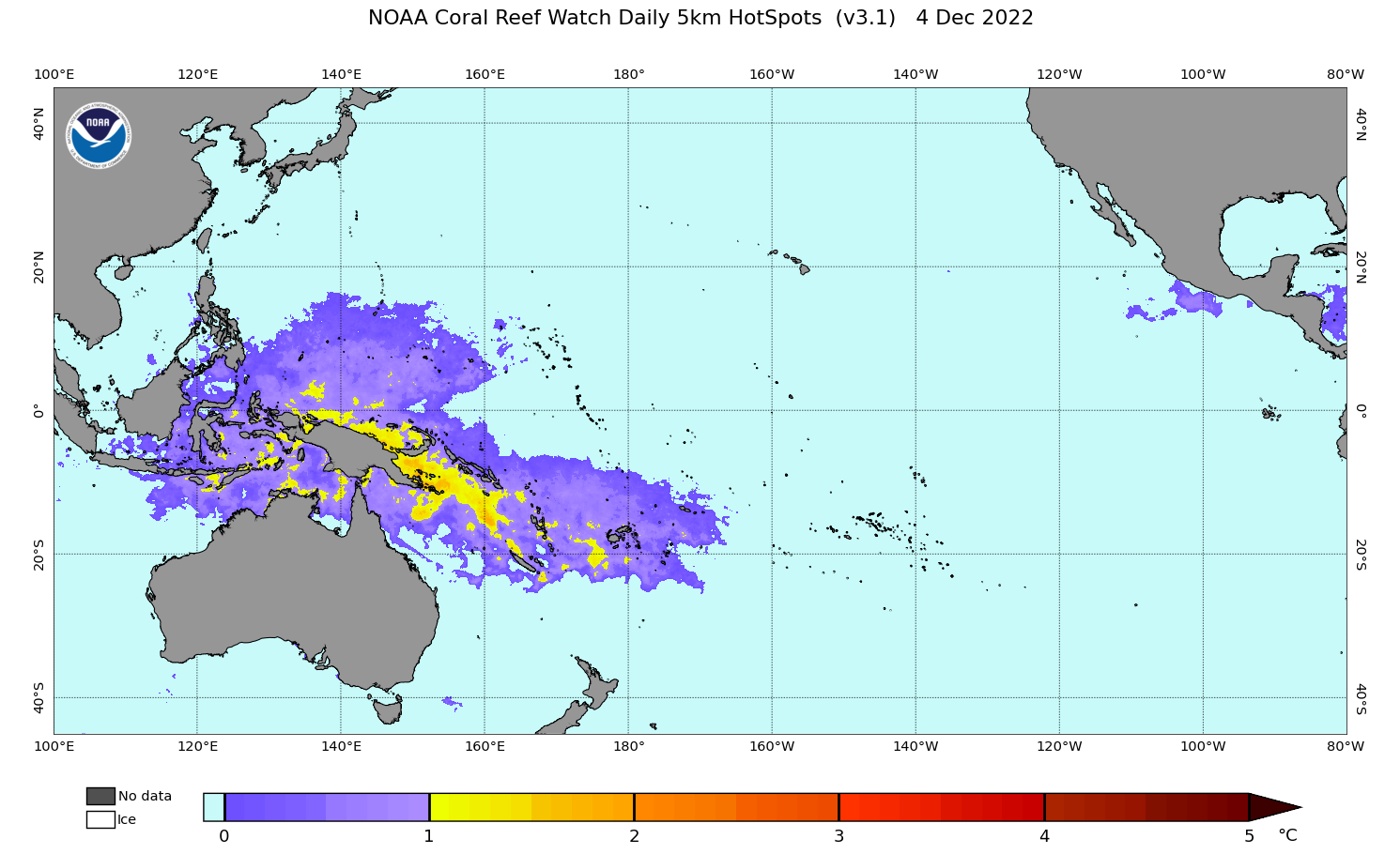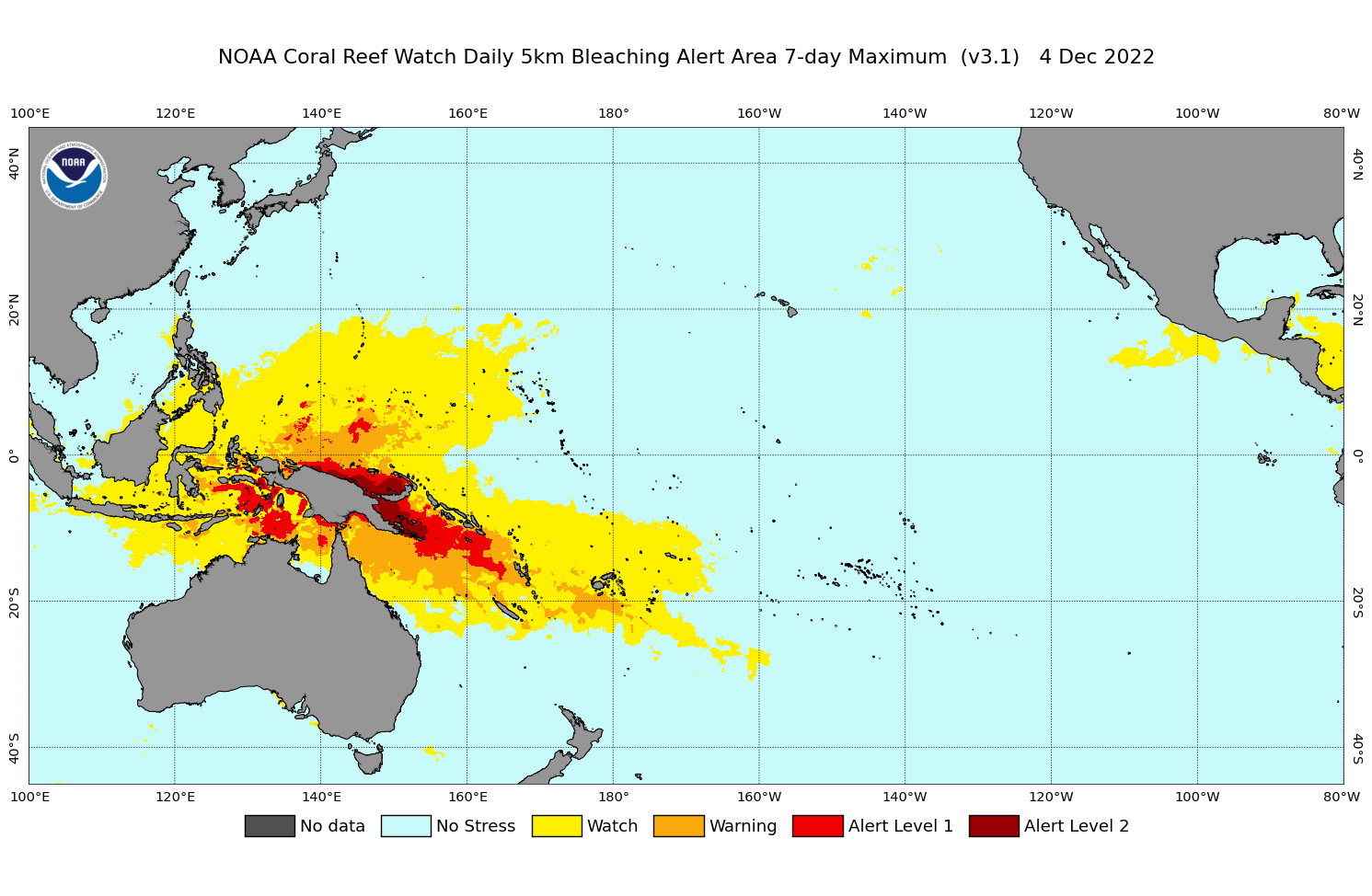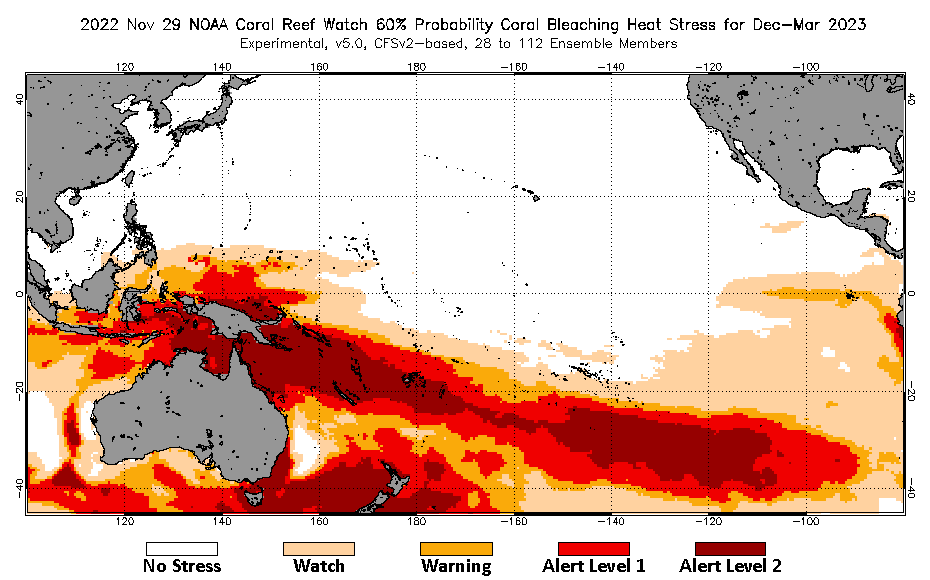Coral Bleaching Heat Stress Analysis and
Seasonal Guidance through March 2023
(Released December 5, 2022)
Current conditions:
NOAA Coral Reef Watch's (CRW) near real-time satellite monitoring shows the sea surface temperature (SST) as being predominantly below-average across most of the central and eastern equatorial Pacific Ocean (Figure 1), which is consistent with the ongoing La Niña. SST anomalies remain above-average in areas of the western Pacific, including the Commonwealth of the Northern Mariana Islands (CNMI), Guam, the Federated States of Micronesia (FSM), Palau, and Papua New Guinea (PNG). Above-average SSTs (as much as 2°C above normal) persisted around the Northwestern Hawaiian Islands (NWHI) from early June to the end of October. In the southern Pacific, above-average SSTs (>2°C above normal) have developed around PNG, the Solomon Islands, Vanuatu, Fiji, and New Caledonia. As of November 10, 2022, the NOAA National Centers for Environmental Prediction's El Niño-Southern Oscillation (ENSO) Alert System status remains at La Niña Advisory. There is a 76% chance of La Niña continuing during Northern Hemisphere winter (December 2022-February 2023), with a transition to ENSO-neutral favored in February-April 2023 (57% chance).

|
||
|
Figure 1. NOAA Coral Reef Watch's Satellite Sea Surface Temperature (SST) Anomaly product for the Pacific region. |
||
Over the past three months, Coral Bleaching HotSpots have diminished in the Northern Hemisphere, with the progression of autumn, but have formed in the western Pacific around PNG (Figure 2). HotSpots >1°C persisted around the NWHI, CNMI, and Guam until early October, after the heat stress first reached Bleaching Alert Level 2 in the NWHI on September 11 and Alert Level 1 in the CNMI on August 22. NOAA CRW received reports of bleaching (i.e., visible paling and bleaching on all genera except for Porites) at Midway Atoll in the NWHI in late September. In October, media outlets in China (e.g., https://news.rthk.hk/rthk/en/component/k2/1672772-20221026.htm) reported that extensive bleaching had occurred in Hong Kong in August; this correlated well with CRW's near real-time satellite monitoring of Alert Level 2 heat stress in the South China Sea from late August to early- to late-September (depending on the area of the South China Sea). Currently, the Coral Triangle is heating up, with almost all daily 5km satellite Regional Virtual Stations at Bleaching Watch or higher (Figure 3). West Papua and Maluku, Indonesia are at Alert Level 1, and PNG is at Alert Level 2.

|
||
|
Figure 2. NOAA Coral Reef Watch's Satellite Coral Bleaching HotSpot product for the Pacific region. |
||

|
||
|
Figure 3. NOAA Coral Reef Watch's Satellite Bleaching Alert Area (7-day maximum) product for the Pacific region. |
||
CRW's most recent, modeled Four-Month Coral Bleaching Outlook (Figure 4) projects heat stress will continue to increase in the Southern Hemisphere through March 2023. Alert Level 2 stress is predicted to reach from PNG and the Great Barrier Reef (GBR), Australia eastward to Fiji by March. Additionally, American Samoa is predicted to reach Bleaching Warning by that time. As NOAA CRW presented at the Pre-Summer GBR Health Workshop organized by the Great Barrier Reef Marine Park Authority (GBRMPA) on November 24, currently, SSTs are at record levels on the GBR for this time of year; SST anomalies across the GBR and Coral Sea are higher than at the same time last year; and CRW's daily global 5km satellite Degree Heating Week (DHW) product is accumulating heat stress already over parts of the GBR - a first for this time of year. It is possible that as with 2016-2017, the GBR could see another back-to-back mass bleaching event this year.

|
||
|
Figure 4. NOAA Coral Reef Watch's Four-Month Coral Bleaching Outlook of November 29, 2022, for the period December 2022-March 2023, for the Pacific region. |
||
***NOTE: We recommend that users continue to monitor updates in the Four-Month Outlook predictions (https://coralreefwatch.noaa.gov/satellite/bleachingoutlook_cfs/index.php), for their regions of interest/concern, over the months ahead, along with the changes in coral bleaching heat stress detected by our near real-time satellite products (https://coralreefwatch.noaa.gov/product/5km/index.php).***
CRW's current satellite and modeled products can be found at:
https://coralreefwatch.noaa.gov/index.php
CRW's modeled Four-Month Coral Bleaching Heat Stress Outlooks can be found at:
https://coralreefwatch.noaa.gov/satellite/bleachingoutlook_cfs/outlook_cfs.php
CRW's 5km satellite Regional Virtual Stations can be found at:
https://coralreefwatch.noaa.gov/product/vs/map.php
Sign up for automated bleaching alert emails for CRW's 5km Regional Virtual Stations at:
https://coralreefwatch.noaa.gov/subscriptions/vs.php
Please report bleaching events (or non-events) at:
https://coralreefwatch.noaa.gov/satellite/research/coral_bleaching_report.php
Disclaimer
The content posted on this web page solely represents the opinions of the authors and does not constitute a statement of policy, decision, or position on behalf of NOAA or the US Government.
The appearance of external links on this World Wide Web site does not constitute endorsement by the Department of Commerce/National Oceanic and Atmospheric Administration of external Web sites or the information, products or services contained therein. For other than authorized activities, the Department of Commerce/NOAA does not exercise any editorial control over the information you may find at these locations. These links are provided consistent with the stated purpose of this Department of Commerce/NOAA Web site.